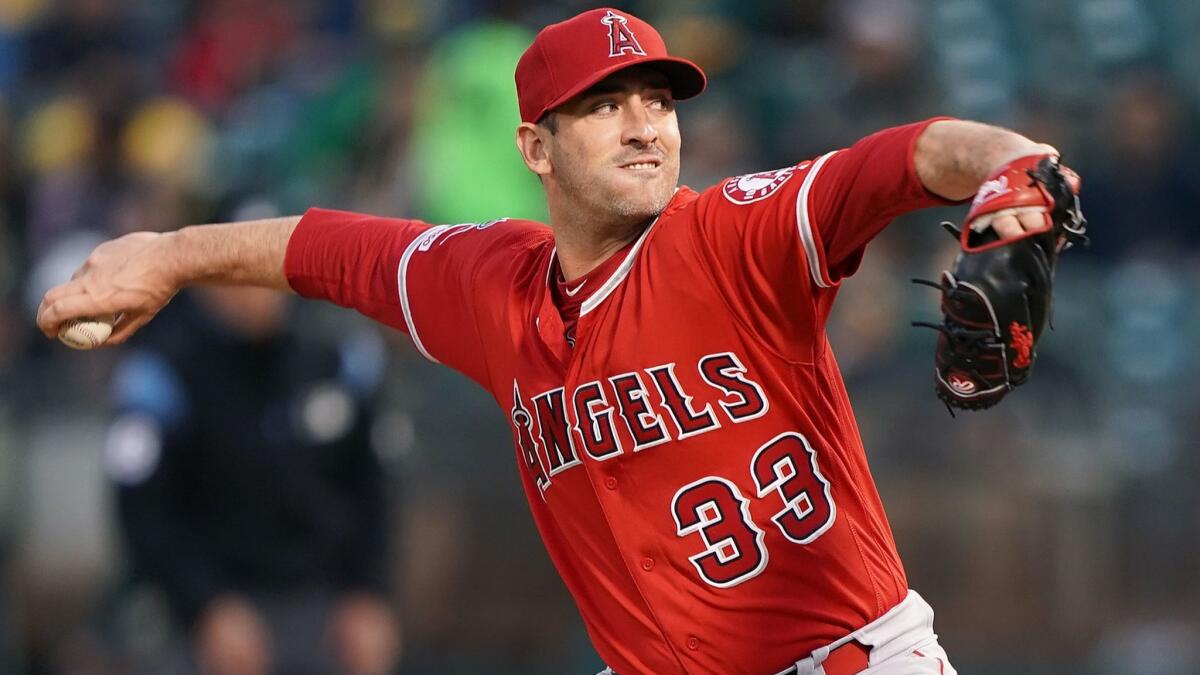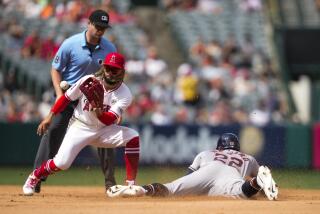Column: Angels need Matt Harvey to regain ‘Dark Knight’ form

- Share via
The baseball soared over the out-of-town scoreboard in left field and vanished into the concrete stands above. Matt Harvey angrily slapped the air in front of him and dropped his head.
If the sixth-inning home run by Khris Davis was a source of disappointment, the entirety of Harvey’s performance in the Angels’ 6-2 victory over the Oakland Athletics confirmed something the right-hander suspected.
“The Dark Knight” has returned.
In his first start for the Angels, the former All-Star limited the Athletics to four hits over six innings of a no-decision at the Oakland Coliseum. The only two runs he allowed were on the home run to Davis, which was launched with two outs and two strikes. He touched 95 mph with his fastball, not the triple-digit heat he delivered when he was an All-Star on the New York Mets, but enough to set up the off-speed pitches that confounded his opponents on this night.
Before the Athletics staged their home-opening ceremony the previous day, Harvey spoke as if he knew he was about to pitch a game like this.
“It’s been a while since I’ve come into a season and know I’m ready, know I’m throwing the ball where I want to,” he said.
Harvey embraced not only the promise of the new season, but the responsibility that accompanied it. He nodded as he listened to the Angels’ situation described to him, how the strength was the offense, how the concern was the pitching and how if he, and he specifically, had to pitch like the Matt Harvey of old if the team was to have any chance of doing something special.
“It’s going to be fun,” he said. “We’re ready to go. We’re going to hold our own.”
He certainly did Friday, as he no-hit the Athletics through four innings. The first hit he allowed was an infield single to Marcus Semien in the fifth. Semien’s dribbler loaded the bases, but Harvey kept the game scoreless by striking out Ramon Laureano and forcing Nick Hundley to ground into a double play.
The performance was as uplifting as news of Justin Upton’s extended absence was dispiriting. Of the starting pitchers on the Angels, only Harvey has the potential to pitch like an ace. Only he is capable of leading an otherwise unproven staff. The game was the first sign he actually might.
The 30-year-old right-hander spent the previous couple of seasons rediscovering this form, only it’s hard to define exactly what “this” is.
“It’s kind of a gray area, where it didn’t feel right for a long time,” he said.
Sign up for our daily sports newsletter »
Harvey recovered quickly from the reconstructive elbow operation he underwent after the 2013 season, as he led the New York Mets to the World Series two seasons later. The procedure he underwent in 2016 to relieve him of thoracic outlet syndrome was another story.
That season, he experienced numbness in his pitching hand, the result of compressed nerves and blood vessels. The procedure to treat the condition consisted of the removal of his top rib and a neck muscle. What followed was a journey through darkness.
“It wasn’t easy at first because there wasn’t much knowledge about what to do, how quick to do things,” Harvey said.
He didn’t know what to make of what he was feeling — or what he wasn’t.
“Your strength isn’t quite there,” he said. “There’s just so much extra space in your neck and shoulder. Nothing hurts or anything, but it’s just a feel thing. You couldn’t really feel where your arm was.”
What Harvey knows now that he didn’t know then was that every home run he would serve up in the coming years would move him closer to something resembling a recovery. Gradually, he was familiarizing himself with his slightly modified body and regaining his feel.
By this point, however, he had already experienced too much success to exercise patience. And because of his well-publicized affinity for the New York nightlife, the public wasn’t tolerant of his declining effectiveness, either.
In his first season after the operation, in 2017, Harvey was 5-7 with a 6.70 earned-run average. He was 0-2 with a 6.00 ERA through his first four starts of last season.
“That’s the mental part of it,” he said. “You know how good you could be. You know what you’re capable of. You’re just physically not ready to quite do that. You know it’s in there. You have to go out there and you have to feel like you’re strong and healthy and able to compete. If you’re not quite there against the best hitters in the world, you’re going to have to issues.”
Looking back, Harvey thinks he started to feel like himself again in his last start with the Mets. He gave up three runs in the first inning and another three in the third, but blanked the Atlanta Braves over the next three innings.
The Mets were out of patience. They moved Harvey to the bullpen, then traded him to the Cincinnati Reds. In 24 starts with the Reds, he was 7-7 with a 4.50 ERA.
Those weren’t Dark Knight numbers, but his statistics weren’t as important as how he felt. What he suspected was confirmed by the radar gun readings, which showed him touching 98 mph with his fastball. In the first month of the season, his average fastball was 93 mph.
“That was huge … just to see the results and to feel that, to feel the good extension, the release of the ball and all that,” he said. “I knew it was in there. I could feel it coming back.”
More came back Friday. In the coming weeks and months, the Angels will be looking for him to recapture even more of what he lost.
Follow Dylan Hernandez on Twitter @dylanohernandez
More to Read
Go beyond the scoreboard
Get the latest on L.A.'s teams in the daily Sports Report newsletter.
You may occasionally receive promotional content from the Los Angeles Times.











